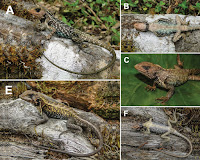 |
| Stenocercus dracopennatus Venegas, García-Ayachi, Chávez-Arribasplata, Chávez, Wong & García-Bravo, 2020 |
Abstract
The tropical Andes are known to be the richest and most diverse place on earth. This mountainous region covers almost one third of the Peruvian territory, and its herpetofauna remains poorly known. The lizard genus Stenocercus Duméril & Bibron, 1837 contains 69 species and most of them occur in the tropical Andes, although some exist as high as 4000 m a.s.l. The examination of newly collected material from the Andes of northern Peru in the Department of Amazonas reveals four new species of Stenocercus which we describe below. Of these four new species, three inhabit the ecoregion of Peruvian Yungas at elevations of 1460 to 2370 m a.s.l., and one the Marañón dry forest ecoregion at elevations of 1340 to 1470 m a.s.l. Additionally, we provide new data about coloration, natural history and distribution of the poorly known S. aculeatus O’Shaughnessy, 1879; and discuss the identity of some populations of S. prionotus Cadle, 2001 and S. scapularis Boulenger, 1901.
Key Words: Andes, herpetofauna, Marañón dry forests, montane forest, morphology, Peruvian Yungas
Stenocercus dracopennatus sp. nov.
Etymology: The specific epithet “dracopennatus” is a noun derived from two words in Latin, “draco” that means dragon, the mythological being, and “pennatus” that means feathered. The specific name is a noun in apposition and refers to the similarity between lizards and dragons, which in both Western and Chinese cultures are beings similar to reptiles like crocodiles or serpents. Moreover, due to the big scales of this new species that give it the appearance of being covered by feathers, we decided to name S. dracopennatus sp. nov. for its resemblance to an imaginary feathered dragon.
Stenocercus catherineae sp. nov.
Etymology: The specific name is a noun in the genitive case and is a patronym for Catherine Dupont, a Peruvian veterinary specialist in One Health, who is actively working searching and monitoring viruses and other zoonotic pathogens. The specific name of this lizard is in recognition of her passion for the natural world and its creatures, and her selfless support of the herpetological division of CORBIDI.
Stenocercus flagracanthus sp. nov.
Etymology: The specific epithet “flagracanthus” is a noun in apposition derived from the Latin words “flagrum” (= whip, derived from “flagellum”) and the Greek “acanthos” (= spine or thorn). It refers to the spiny tail of this new species of lizard that resembles the ancient Roman torture tool, the “flagrum”, a whip-like instrument with accessories for inflicting damage.
Stenocercus philmayi sp. nov.
Etymology: The specific epithet philmayi is a noun in the genitive case and is a patronym for Philip May (1946–2017), an American lichenologist and philanthropist, who was passionate about protecting biological diversity. During his life-time, his generous support of Nature and Culture International was instrumental to the protection of endangered ecosystems and endemic species in the Amazonas, Cajamarca, and La Libertad departments of Peru. Even after his death in 2018, his generosity has continued to protect Latin America’s biodiversity through charitable bequests. This new species was discovered in one of the departments that May supported during his life, and naming it after him, honors May’s enduring legacy as a champion of biodiversity.
Pablo J. Venegas, Luis A. García-Ayachi, Juan C. Chávez-Arribasplata, Germán Chávez, Iván Wong and Antonio García-Bravo. 2020. Four New Species of Stenocercus Duméril & Bibron, 1837 (Squamata, Iguania) from the Department of Amazonas in northeastern Peru. Evolutionary Systematics. 4(2): 79-108. DOI: 10.3897/evolsyst.4.57578


